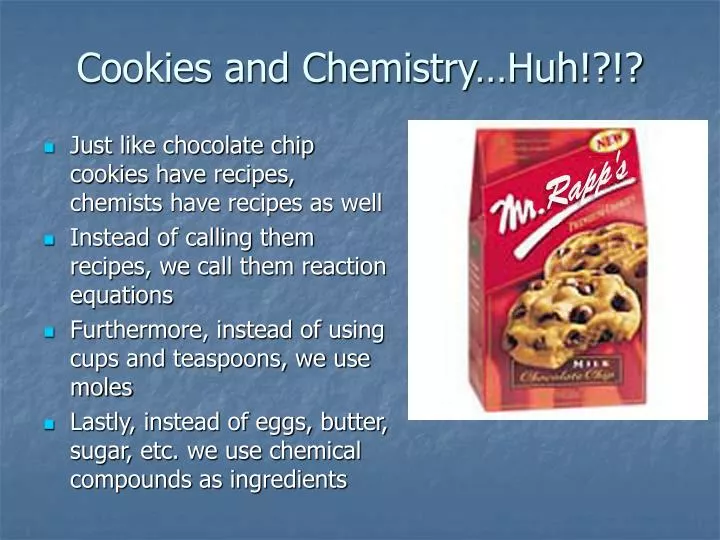
Plain chocolate chips or chunks. Beat in the matured ovum and then vanilla.

The Chemists Recipe for Chocolate Chip Cookies.
Chemistry of chocolate chip cookies. The real live chemistry of baking chocolate chip cookies. When dough reaches 92 degrees F butter inside melts causing the dough to spread out and triple in volume. An emulsion- mixture of 2 substances that dont want to stay together water and fat at 144 degrees F protein starts to change- come from eggs in dough.
1 cup 2 sticks butter softened C 9 H 14 O 6 34 cup granulated sugar C 12 H 22 O 11 34 cup brown sugar C 12 H 22 O 11 1 teaspoon vanilla extract C 8 H 8 O 3 2 large eggs C 6 H 12 O 3 N 2 2 cups 12-oz. Pkg chocolate chips C 4 H 8 O 4 Provided by NESTLÉ TOLL HOUSE. Chemistry of Chocolate Chip Cookies By Thoa Nguyen Experimental Design Essential Question Soft and Chewy Cookies Thin and Crispy Cookies Cakey Cookies Control Chocolate Chip Cookie Answer to EQ Control Chocolate Chip Cookie 2 14 cups all-purpose flour 12 teaspoon baking soda 1.
So what are chocolate chip cookies made from. The most common ingredients are. Plain chocolate chips or chunks.
Preheat the oven to 190C. Line two baking trays with non-stick baking paper. Pre heat oven to 453 K.
In a large bowl mix the Partially-hydrogenated soybean and cottonseed oils mono and diglycerides sucrose and dark crystalline sugar together until a fluffy homogenous mixture is obtained. Beat in the matured ovum and then vanilla. In another bowl gently mix the dry ingredients flour oatmeal baking powder and.
The Chemists Recipe for Chocolate Chip Cookies. The following recipe for chocolate chip cookies recently appeared in Chemical Engineering News CEN Jun 19 1995 p. It was attributed to Jeannene Ackerman of Witco Corp.
Nestle Tollhouse Cookie Recipe. Caramelization which gives cookies their nice brown tops occurs above 356 degrees says the TEDEd video. Crispy with a soft center.
Use 14 teaspoon baking powder and 14. At 310 degrees the so-called Maillard Reactions begin. Here proteins and sugars break down and create hundreds of flavor and aroma compounds turning browner in the process.
And theres more such as what happens when baking soda reacts with acids in the dough and the final hottest process called caramelization.